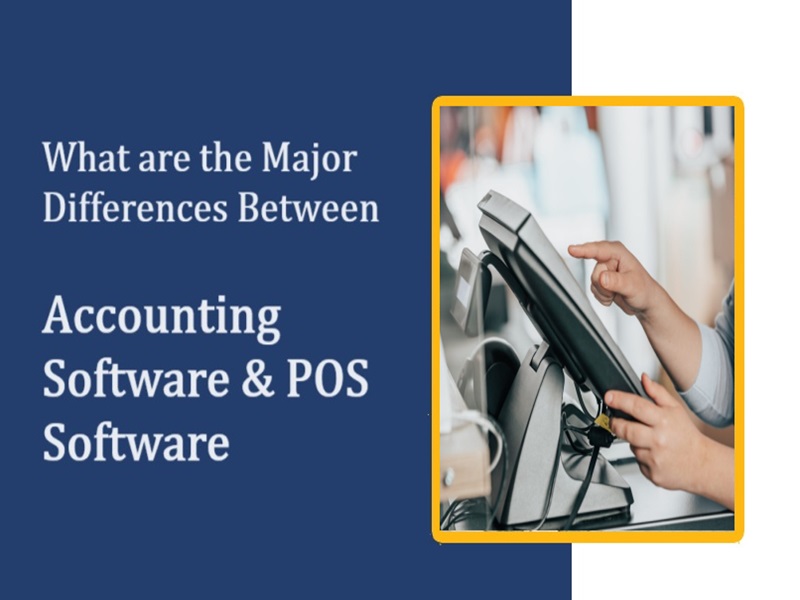What are the Major Differences Between Accounting Software and POS Software

In the business management world, two critical tools play pivotal roles in streamlining operations and ensuring financial accuracy—Accounting Software and Point of Sale (POS) Software. While both are essential for a well-functioning business, they serve distinct purposes and cater to different aspects of financial management.
Differences between Accounting Software and POS Software
1. Primary Functionality
Accounting Software: Accounting software is designed to manage and track the overall financial health of a business. It encompasses a wide array of features, including general ledger management, accounts payable and receivable, financial reporting, and budgeting. The primary focus is on maintaining accurate records of financial transactions and providing a comprehensive view of the company’s financial status.
POS Software: On the other hand, POS software is specifically tailored for managing sales transactions. It facilitates the processing of sales, tracking inventory levels, and generating receipts. The primary objective of POS software is to enhance the efficiency of the sales process and ensure a seamless customer experience.
2. Scope of Functionality
Accounting Software: Accounting software often involves complex functionalities, addressing various aspects of financial management. It is capable of handling tasks such as payroll processing, tax management, and financial analysis. This comprehensive approach makes accounting software suitable for businesses of all sizes, from small enterprises to large corporations.
POS Software: POS software, while crucial for retail businesses, focuses primarily on sales-related tasks. It streamlines the checkout process, tracks sales in real-time, and manages inventory levels. POS systems are particularly beneficial for businesses with a significant emphasis on customer transactions, such as retail stores and restaurants.
3. Integration Capabilities
Accounting Software: Accounting software typically integrates with various business applications, including customer relationship management (CRM) systems, payment processors, and banking platforms. This integration ensures a seamless flow of financial data across different aspects of the business, promoting accuracy and efficiency.
POS Software: POS software integrates with inventory management systems, allowing businesses to keep track of stock levels and automate reorder processes. Additionally, POS systems may integrate with accounting software to synchronize sales data, providing a consolidated view of financial transactions.
4. User Interface and Accessibility
Accounting Software: Given the complexity of its functionalities, accounting software tends to have a more intricate user interface. It is designed for accounting professionals and financial experts who require in-depth insights into the company’s financial data. Accessibility may be limited to trained personnel within the organization.
POS Software: POS software, on the other hand, prioritizes user-friendliness and efficiency. The interface is often intuitive and straightforward, catering to users at various skill levels. Front-line staff, such as cashiers and sales associates, can quickly adapt to POS systems, contributing to a smoother customer checkout experience.
5. Reporting and Analysis
Accounting Software: One of the primary strengths of accounting software lies in its robust reporting and analysis capabilities. Businesses can generate comprehensive financial reports, analyze performance metrics, and make data-driven decisions. These features are vital for strategic planning and long-term financial management.
POS Software: While POS software provides essential sales reports and inventory tracking, its reporting capabilities are more focused on immediate operational needs. Sales trends, popular products, and inventory turnover are commonly analyzed to make timely adjustments to the business strategy.
6. Target Users
Accounting Software: Accounting software is tailored for finance professionals, accountants, and business owners who need to manage the overall financial health of the organization. It serves as a comprehensive tool for financial planning, compliance, and reporting.
POS Software: POS software is geared towards businesses that engage in frequent customer transactions, such as retail stores, restaurants, and hospitality establishments. Its primary users include front-line staff responsible for processing sales and managing inventory.
Conclusion
In conclusion, while accounting software and POS software both contribute to the efficient functioning of a business, their distinct purposes make them complementary rather than interchangeable. Accounting software is the backbone of financial management, ensuring accuracy and compliance, while POS software optimizes the sales process and enhances customer service. Understanding the major differences between the two is crucial for businesses to choose the right tools that align with their specific needs and industry requirements.